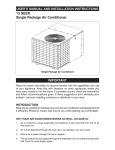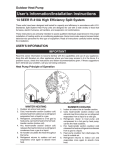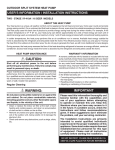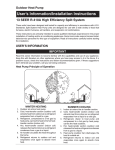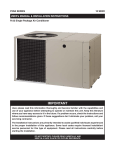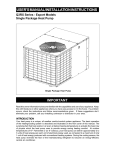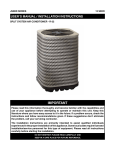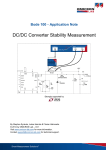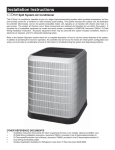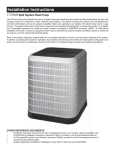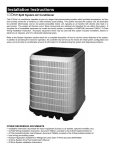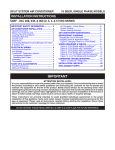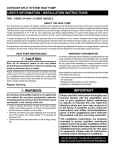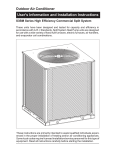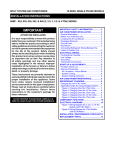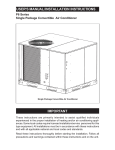Download warning - Nordyne
Transcript
13 SEER P5RD SERIES USER’S MANUAL & INSTALLATION INSTRUCTIONS Single Package Air Conditioner - Single Stage, R-410A IMPORTANT Please read this information thoroughly and become familiar with the capabilities and use of your appliance before attempting to operate or maintain this unit. Keep this literature where you have easy access to it in the future. If a problem occurs, check the instructions and follow recommendations given. If these suggestions don’t eliminate your problem, call your servicing contractor. The Installation Instructions are primarily intended to assist qualified individuals experienced in the proper installation of this appliance. Some local codes require licensed installation/ service personnel for this type of equipment. Please read all instructions carefully before starting the installation. DO NOT DESTROY. PLEASE READ CAREFULLY AND KEEP IN A SAFE PLACE FOR FUTURE REFERENCE. USER INFORMATION Important Safety Information ....................................3 WARRANTY INFORMATION Operating Instructions ...............................................3 Cooling Operation .....................................................3 Heating Operation .....................................................3 Turning the Air Conditioner Off ..................................3 Operating the Indoor Blower Continuously ................3 A warranty certificate with full details is included with the Air Conditioner. Carefully review these responsibilities with your dealer or service company. The manufacturer will not be responsible for any costs found necessary to correct problems due to improper setup, improper installation, adjustments, improper operating procedure on the part of the user, etc. Some specific examples of service calls which are not included in the limited warranty are: • Correcting wiring problems in the electrical circuit supplying the Air Conditioner. • Resetting circuit breakers or other switches. • Adjusting or calibrating of thermostat. Air Conditioner Maintenance.....................................3 Troubleshooting..........................................................3 INSTALLER INFORMATION Important Safety Information ....................................4 General Information ...................................................5 Before You Install this Unit .........................................5 Locating the Air Conditioner .....................................5 Minimum Clearance Requirements ..........................5 Service Access Clearances ..................................5 Clearances to Combustible Materials ...................5 Air Duct System ........................................................5 Air Conditioner Installation .......................................6 Unpacking the Unit ...................................................6 Installing Return & Supply Collars.............................6 Supply Duct ...........................................................6 Return Duct ...........................................................7 Locating & Installing the Return Air Assembly ..........7 Connecting the Return & Supply Air Flexible Ducts .........................................................................7 Locating & Installing the Supply Dampers.................7 Condensate Drainage ..............................................8 Electrical Connections ...............................................8 Pre - Electrical Checklist ...........................................8 Line Voltage ...............................................................8 Overcurrent Protection ..............................................9 Grounding..................................................................9 Thermostat / Low Voltage Connections .....................9 Cooling Thermostat ................................................9 Heat/Cool Thermostat ............................................9 Blower Speed .........................................................10 Standard PSC Motor ............................................10 High Efficiency ECM Motor ..................................10 2 Startup & Adjustments ............................................10 Pre - Start Checklist ................................................10 Start - Up Procedure ...............................................10 System Cooling ....................................................10 Emergency Heat ..................................................11 Adjustment of Refrigerant Charge ...........................11 Charging an R410A Unit in AC Mode with Outdoor Temperatures above 55° F ......................................12 Air Conditioner Maintenance...................................12 Component Functions .............................................12 High Pressure Switch ..............................................12 Low Pressure Switch ...............................................12 Replacement Parts ...................................................12 Figures & Tables .......................................................13 Figure 10 - Phys. Data & Unit Dimensions ...........13 Wiring Diagrams ......................................................14 Figure 11 - P5RD - w/ ECM Motor .......................14 Figure 12 - P5RD - w/ PSC Motor ........................15 Refrigerant Charging Tables ....................................16 Table 4 - P5RD-024K (2 Ton Units) ......................16 Table 5 - P5RD-030K (2.5 Ton Units) ...................16 Table 6 - P5RD-036K (3 Ton Units) ......................17 Table 7 - P5RD-042K (3.5 Ton w/ X-13 Motor) .....17 Table 8 - P5RD-042KA (3.5 Ton w/ PSC Motor)...18 Table 9 - P5RD-048K (4 Ton Units) ......................18 Figure 13 - P5RD-048KA (4 Ton w/ TXV Valve) ...19 Table 10 - P5RD-060K 5 Ton Units ......................19 Installation / Performance Checklist .......................20 USER INFORMATION IMPORTANT SAFETY INFORMATION Safety markings are used to designate a degree or level of seriousness and should not be ignored. WARNING indicates a potentially hazardous situation that if not avoided, could result in personal injury or death. CAUTION indicates a potentially hazardous situation that if not avoided, may result in minor or moderate injury or property damage. OPERATING INSTRUCTIONS NOTE: Thermostat styles vary. Some models may not include the AUTO mode and others will have the AUTO in place of the HEAT and COOL. Others may include all three. Please refer to the thermostat manufacturer’s User manual for detailed programming instructions. Cooling Operation 1. Set the thermostat’s system mode to COOL or AUTO and change the fan mode to AUTO. See Figure 1. 2. Set the temperature selector to the desired temperature level.The outdoor fan, compressor, and blower motor will all cycle on and off to maintain the indoor temperature at the desired cooling level. Heating Operation (if optional heater kit is installed) 1. Set the thermostat’s system mode to HEAT or AUTO and change the fan mode to AUTO. See Figure 1. 2. Set the temperature selector to the desired temperature level. The outdoor fan, blower motor, and heater kit will cycle on and off to maintain the indoor temperature at the desired heating level. Turning the Air Conditioner OFF Change the thermostat’s system mode to OFF and the fan mode to AUTO (See Figure 1). NOTE: The system will not operate, regardless of the temperature selector setting. Operating the Indoor Blower Continuously The continuous indoor blower operation is typically used to circulate the indoor air to equalize a temperature unbalance due to a sun load, cooking, or fireplace operation. Set the thermostat fan mode to ON (Figure 1). The indoor blower starts immediately, and will run continually until the fan mode is reset to AUTO. The continuous indoor blower operation can be obtained with the thermostat system mode set in any position, including OFF. AIR CONDITIONER MAINTENANCE Proper maintenance is most important to achieve the best performance from the appliance and should be performed frequently at the beginning of each air conditioning season. WARNING: Your Air Conditioner contains liquid and gaseous refrigerant under pressure. Installation and servicing should only be attempted by qualified, trained personnel thoroughly familiar with the equipment and safe responsible refrigerant handling procedures. Failure to comply with this warning could result in equipment damage, personal injury, or death. • Keep the unit clean. Hose off periodically and keep unit fins clear of leaves and grass clippings. • Keep the unit clear of obstructions. DO NOT obstruct airflow with tall plants or shrubs. DO NOT store gasoline or other flammable materials on or near the unit. • Never operate the appliance without a filter installed in the return air duct. Inspect filters frequently and replace when necessary with filter of same dimensional size. TROUBLESHOOTING If the unit fails to operate, check the following: • Check the thermostat setting. Make sure the system mode and temperature settings are correct. • Check the electrical panel for tripped circuit breakers. • Check the filters for dust accumulation. • Check the unit and make sure it is clean and not covered with grass or leaves. • If the items above don’t resolve your problems, then call your nearest service technician. FAN MODE SYSTEM MODE TEMPERATURE SELECTOR Figure 1. Digital Thermostat 3 INSTALLER INFORMATION IMPORTANT SAFETY INFORMATION Please read all instructions before servicing this equipment. Pay attention to all safety warnings and any other special notes highlighted in the manual. Safety markings are used frequently throughout this manual to designate a degree or level of seriousness and should not be ignored. WARNING indicates a potentially hazardous situation that if not avoided, could result in personal injury or death. CAUTION indicates a potentially hazardous situation that if not avoided, may result in minor or moderate injury or property damage. WARNING: Shut off all electrical power to the unit before performing any maintenance or service on the system. Failure to comply may result in personal injury or death. WARNING: Unless noted otherwise in these instructions, only factory authorized parts or accessory kits may be used with this product. Improper installation, service, adjustment, or maintenance may cause explosion, fire, electrical shock or other hazardous conditions which may result in personal injury or property damage. WARNING: P5RD units are fully charged with R-410A refrigerant and ready for installation. When a system is installed according to these instructions, no refrigerant charging is required. If repairs make it necessary for evacuation and charging, it should only be attempted by qualified, trained personnel thoroughly familiar with this equipment. Some local codes require licensed installation service personnel to service this type of equipment. Under no circumstances should the equipment owner attempt to install and/or service this equipment. Failure to comply with this warning could result in equipment damage, personal injury, or death. 4 CAUTION: This unit uses refrigerant R-410A. DO NOT use any other refrigerant in this unit. Use of another refrigerant will damage the unit. WARNING: The information listed below must be followed during the installation, service, and operation of this unit. Unqualified individuals should not attempt to interpret these instructions or install this equipment. Failure to follow safety recommendations could result in possible damage to the equipment, serious personal injury or death. • The installer must comply with all local codes and regulations which govern the installation of this type of equipment. Local codes and regulations take precedence over any recommendations contained in these instructions. Consult local building codes and the National Electrical Code (ANSI CI) for special installation requirements. • All electrical wiring must be completed in accordance with local, state and national codes and regulations and with the National Electric Code (ANSI/NFPA 70) or in Canada the Canadian Electric Code Part 1 CSA C.22.1. • This equipment contains liquid and gaseous refrigerant under high pressure. DO NOT USE ANY PORTION OF THE CHARGE FOR PURGING OR LEAK TESTING. Installation or servicing should only be performed by qualified trained personnel thoroughly familiar with this type equipment. • This unit is designed for outdoor installations only and should be located in a position as shown on page 5. • Follow all precautions in the literature, on tags, and on labels provided with the equipment. Read and thoroughly understand the instructions provided with the equipment prior to performing the installation and operational checkout of the equipment. The P5RD packaged air conditioner is designed only for outdoor ground level installations and can be readily connected to the high static duct system of a home.This unit has been tested for capacity and efficiency in accordance with A.R.I. Standards and will provide many years of safe and dependable comfort, providing it is properly installed and maintained. Abuse, improper use, and/or improper maintenance can shorten the life of the appliance and create unsafe hazards. To achieve optimum performance and minimize equipment failure, it is recommended that periodic maintenance be performed on this unit. The ability to properly perform maintenance on this equipment requires certain mechanical skills and tools. Before You Install this Unit The cooling load of the area to be conditioned must be calculated and a system of the proper capacity selected. It is recommended that the area to be conditioned be completely insulated and vapor sealed. Check the electrical supply and verify the power supply is adequate for unit operation. If there is any question concerning the power supply, contact the local power company. All units are securely packed at the time of shipment and upon arrival should be carefully inspected for damage prior to installing the equipment at the job site. Verify coil fins are straight. If necessary, comb fins to remove flattened or bent fins. Claims for damage (apparent or concealed) should be filed immediately with the carrier. Please consult your dealer for maintenance information and availability of maintenance contracts. Please read all instructions before installing the unit. Locating the Air Conditioner • Survey the job site to determine the best location for mounting the outdoor unit. Select a solid, level position, preferably on a concrete slab, slightly above the grade level, and parallel to the home. If possible, select a site for the unit that is as close as possible to the proposed return grille location. DO NOT PLACE UNIT UNDER THE HOME. • The unit should be located with consideration of minimizing the length of the supply and return ducts. If practical, place the air conditioner and its ducts in an area where they will be shaded from the afternoon sun, when the heat load is greatest. • The length of the supply and return ducts should be kept to a minimum with no sharp radius bends. • Overhead obstructions, poorly ventilated areas, and areas subject to accumulation of debris should be avoided. The hot condenser air must be discharged up and away from the home, and if possible, in a direction with the prevailing wind. Do not place the unit in a confined space. See Figure 10 (page 13) for unit dimensions. • Sufficient clearance for unobstructed airflow through the outdoor coil must be maintained in order to achieve rated performance. • Consideration should also be given to availability of electric power, service access, noise, and shade. Minimum Clearance Requirements Sufficient clearance for unobstructed airflow through the outdoor coil must be maintained in order to provide room for proper servicing and achieve rated performance. See Figure 2 for minimum clearances to obstructions. Service Access Clearances Blower access panel side ..........................................24” Electrical compartment access panel side ................12” Clearance between overhang & top of unit................72” Clearance around condenser coil area to wall or shrubs (excludes duct panel side) .............................12” Clearances to Combustible Materials Supply and return air ducts .........................................0” Duct connection side ...................................................0” 12" 24" TOP OF UNIT TO BE UNOBSTRUCTED GENERAL INFORMATION 12" 0" Figure 2. Minimum Unit Clearances Air Duct System Air ducts must be installed in accordance with the standards of the National Fire Protection Association “Standard for Installation of Air Conditioning and Ventilation Systems” (NFPA 90A), “Standard for Installation of Residence Type Warm Air Heating and Air Conditioning Systems” (NFPA 90B), these instructions, and all applicable codes. NFPA publications are available by writing to: National Fire Protection Association, Batterymarch Park, Quincy, ME 02269 or visit www.NFPA.org on the web. • Design the duct work according to methods described by the Air Conditioning Contractors of America (ACCA). • The supply duct system, including the number and type of registers, will have much more effect on the performance of the system than any other factor. The duct must be sufficiently large to conduct an adequate amount of air to each register. See Figure 3 (page 6). 5 SINGLE DUCT APPLICATION MULTIPLE DUCT APPLICATION Figure 3. Single & Multiple Duct Applications • Duct work should be attached directly to the unit flanges for horizontal applications. • For highly resistive duct systems it may be necessary to add an additional return air duct and or supply to achieve maximum performance and prevent coil icing and refrigerant flood back. • The heat pump system will not cool or heat the home if air is lost to the outside through leaks in the duct system. Ducts that are collapsed or restricted by foreign objects will also prevent adequate air flow. • All duct work passing through unconditioned space must be properly insulated to minimize duct losses and prevent condensation. Use insulation with an outer vapor barrier. Refer to local codes for insulation material requirements. ir Supply A ir Return A Figure 4. Return & Supply Air Collars 6 CAUTION: Do not tip the unit on its side. Oil may enter the compressor cylinders and cause starting trouble. If unit has been set on its side, restore to upright position and do not run for several hours. Then run unit for a few seconds. Do this three or four times with five minutes between runs. 1. Remove the bands from around the unit. 2. Unfold the top and bottom cap flanges. 3. Carefully remove the top cap and tube. Duct Dimples Transition ws Duct Scre AIR CONDITIONER INSTALLATION Unpacking the Unit It is recommended that the unit be unpacked at the installation site to minimize damage due to handling. Installing Return & Supply Air Collars If the supply and return collars are supplied with the unit, they will be located in the supply duct. They can be easily positioned over the unit openings (Figure 4) and secured with sheet metal screws. • The diameter of the return duct collar is 14”. • The diameter of the supply duct collar is 12”. • Before permanently installing the collars, it is recommended you pre-fit them over the openings first to determine best fit and alignment. Supply Duct 1. Position the supply duct collar so the edge of the unit opening fits between the flange and the bead. 2. Overlap the collar ends keeping the small screw holes underneath. 3. Align the holes in the crimped area and install one screw. NOTE: It may be necessary to loosen the four screws that hold the transition duct in order to install the supply fitting. Re-tighten when installation is complete. 4. Tap collar (if necessary) to ensure engagement with unit opening and install second screw. 5. Tighten first screw and rotate collar clockwise so joint is near three o’clock position. Return Duct 1. Assemble the collar by overlapping the two ends. NOTE: One end of the collar is slotted and the opposite end has two small holes. Position the end with small screw holes underneath the slotted end. 2. Fasten the collar ends with two self drilling sheet metal screws. 3. Position the collar over the unit opening. Align the four holes in the collar with the four dimples or holes (depending on unit model) in the panel. 4. Secure the collar to the rear panel using self drilling screws (10-16x.5). Locating & Installing the Return Air Assembly To simplify installation, locate and install the return air assembly first. If desired, the return opening can be located inside a closet with louvered doors that has an open area equal to or greater than a 12” x 20” grille. The return air grille can be placed in the wall of a closet and the air ducted into the filter box through a boxed-in area at the closet floor level (Figure 5). Verify the filter is readily accessible. the floor. However, if the floor is more than ten inches deep, it will only be necessary to cut a hole for the collar on the return air box or for the insulated duct. 3. Set the box into the opening and fasten with screws or nails. 4. Install the filter and return air grille in the air box. Connecting the Return & Supply Air Flexible Ducts • Flexible ducts can be connected to the corresponding fittings with the clamps provided with the ducts. See Figure 10 (page 13). NOTE: To prevent a loss in cooling capacity, make sure all connections are tight. • The flexible ducts may be cut to the required length, see instructions packed with duct. Keep all ducts as short and straight as possible. Avoid sharp bends. • Ducts may be spliced with sheet metal sleeves and clamps. • After the inner duct is connected to the proper fitting, the insulation and plastic sleeve should be pulled over the connection and clamped. • Homes with multiple supply ducts (or special applications), a Y fitting is available to divide the supply air so it can be ducted to different areas of the home for more efficient cooling. NOTE: For maximum performance, insulate the Y fitting. Locating & Installing the Supply Damper(s) NOTE: The return air box with grille and filter should not be located in heavy traffic areas like hallways or center of rooms. A good spot is in a corner or under a table, if a minimum two inch clearance is available. 1. Start the installation from under the home by cutting a small hole in the subfloor. Determine how the floor joist location will affect cutting the opening needed for the return air box. NOTE: Floor joists are generally located on 16” centers, leaving 14-3/8” between joists. 2. After measuring the return air box (approximately 121/4” x 20-1/4”), cut the hole through the floor so that the box will fit between the floor joists. Care should be taken when cutting through carpeting to avoid snags. NOTE: In most installations it will be necessary to cut a similar hole in the fiberboard directly under the hole in CAUTION: If installing this air conditioning system in conjunction with a furnace, a damper must be installed in the furnace base assembly to prevent cold air from being discharged around the heat exchanger. Damage to the heat exchanger and asphyxiation may occur if a damper is not installed. Check with the furnace manufacturer for damper requirements. Failure to install the required furnace damper may invalidate code agency listing and limited warranty on the furnace. When locating the supply damper(s), carefully check floor joists and frame members that could interfere with the installation of the damper or flexible duct. Ideally, the damper (Figure 6, page 8) should be located in the bottom of the main duct, forward of center of the home, at least three feet from the nearest register. The round supply opening in the slanted side of the damper should face the side of the home where the air conditioner is located. Figure 5. Return Air Box 1. Locate the center of the heat duct by cutting a small hole in the fiberboard below the duct at the desired location. 2. Cut a hole approximately 3/4” larger than the damper opening in the fiberboard. 7 3. Cut a 9-1/8” x 13-1/8” hole in the duct and bend over all tabs flat on the inside of the heat duct. 4. Insert the damper into the duct and bend over all tabs flat on the inside of the heat duct. 5. Seal the opening between the fiberboard and damper or flexible duct. ELECTRICAL CONNECTIONS WARNING: To avoid risk of electrical shock, personal injury, or death, disconnect all electrical power to the unit before performing any maintenance or service. The unit may have more than one electrical supply. Label all wires prior to disconnection when servicing the unit. Wiring errors can cause improper and dangerous operation Figure 6. Supply Damper Condensate Drainage A 3/4” condensate fitting extends out of the side of the unit (Figure 7). The drain trap, shipped in the electrical compartment, must be installed to prevent water from collecting inside the unit. 1. Thread the elbow provided with the unit into the drain connection until hand tight. 2. Connect the condensate tubing onto the fitting, forming a trap near the drain connection. 3. Route the condensate tube from the trap to a suitable drain. NOTE: For proper drainage, make sure the trap is level to the ground and tubing outlet is below trap level. Elbow P-Trap Figure 7. Drain Trap Line Voltage Low Voltage Figure 8. Power Entry 8 • All electrical connections must be in compliance with all applicable local codes and ordinances, and with the current revision of the National Electric Code (ANSI/NFPA 70). • For Canadian installations the electrical connections and grounding shall comply with the current Canadian Electrical Code (CSA C22.1 and/or local codes). Pre-Electrical Checklist Verify that the voltage, frequency, and phase of the supply source match the specifications on the unit rating plate. Verify that the service provided by the utility is sufficient to handle the additional load imposed by this equipment. Refer to the unit wiring label for proper high and low voltage wiring. Verify factory wiring is in accordance with the unit wiring diagram (Figures 11 or 12, pages 14 - 15). Inspect for loose connections. Line Voltage • A wiring diagram is located on the inside cover of the electrical box of the unit. The installer should become familiar with the wiring diagram before making any electrical connections to the unit. • An electrical disconnect must be located within sight of and readily accessible to the unit. This switch shall be capable of electrically de-energizing the unit. • Line voltage to the unit should be supplied from a dedicated branch circuit containing the correct fuse or circuit breaker for the unit. Incoming field wiring and minimum size of electrical conductors and circuit protection must be in compliance with information listed on the unit data label. Any other wiring methods must be acceptable to authority having jurisdiction. • Provide power supply for the unit in accordance with the unit wiring diagram, and the unit rating plate. Connect the line-voltage leads to the terminals on the contactor inside the control compartment. Extend leads through power wiring hole (Figure 8). Connect L1 & L2 directly to the contactor. • The unit requires both power and control circuit electrical connections. Refer to the wiring diagram / schematic (Figures 11 & 12, pages 14 & 15) for identification and location of unit field wiring interfaces. Make all electrical connections in accordance with all applicable codes and ordinances. • Overcurrent protection must be provided at the branch circuit distribution panel and sized as shown on the unit rating label and according to applicable local codes. See the unit rating plate for minimum circuit ampacity and maximum overcurrent protection limits. • Use only copper wire for the line voltage power supply to this unit as listed in Table 1. Use proper code agency listed conduit and a conduit connector for connecting the supply wires to the unit. Use of rain tight conduit is recommended. • 208/230 Volt units are shipped from the factory wired for 230 volt operation. For 208V operation, remove the lead from the transformer terminal marked 240V and connect it to the terminal marked 208V. • Optional equipment requiring connection to the power or control circuits must be wired in strict accordance of the NEC (ANSI/NFPA 70), applicable local codes, and the instructions provided with the equipment. Overcurrent Protection Generally, the best fuse or breaker for any air conditioner is the smallest size that will permit the equipment to run under normal usage and provide maximum equipment protection. Properly sized fuses and breakers also prevent nuisance trips during unit startup. If a fuse blows or a breaker trips, always determine the reason. Do not arbitrarily install a larger fuse or breaker and do not, in any case, exceed the maximum size listed on the data label of the unit. COPPER WIRE SIZE — AWG (1% Voltage Drop) Supply Wire Length-Feet 200 6 4 4 4 3 3 2 2 2 1 150 8 6 6 4 4 4 3 3 3 2 100 10 8 8 6 6 6 4 4 4 3 50 14 12 10 10 8 8 6 6 6 4 Supply Circuit Ampacity 15 20 25 30 35 40 45 50 55 60 Wire Size based on N.E.C. for 60° type copper conductors. Table 1. Copper Wire Size Grounding WARNING: The unit cabinet must have an uninterrupted or unbroken electrical ground to minimize personal injury if an electrical fault should occur. Do not use gas piping as an electrical ground! This unit must be electrically grounded in accordance with local codes or, in the absence of local codes, with the National Electrical Code (ANSI/NFPA 70) or CSA C22.1 Electrical Code. Ground the air conditioning unit using the green grounding screw provided in the control panel. Thermostat / Low Voltage Connections • The unit is designed to operate from a 24 VAC Class II control circuit. The control circuit wiring must comply with the current provisions of the NEC (ANSI/NFPA 70) and with applicable local codes having jurisdiction. Thermostat connections should be made in accordance with the instructions supplied with the thermostat and the indoor equipment. • The low voltage wires must be properly connected. Route 24V control wires through the sealing grommet (Figure 8, page 8) near the power entrance. Recommended wire gauge and wire lengths for typical thermostat connections are listed in Table 2 (page 10). • Single stage or two-stage thermostats can be used with this equipment depending on optional accessories (i.e. economizer) installed with the unit. Select a thermostat that operates in conjunction with the installed accessories. • The thermostat should be mounted about 5 feet above the floor on an inside wall. DO NOT install the thermostat on an outside wall or any other location where its operation may be adversely affected by radiant heat from fireplaces, sunlight, lighting fixtures or convective heat from warm air registers or electrical appliances. Refer to the thermostat manufacturer’s instruction sheet for detailed mounting information. Cooling Only Thermostat Connect the red & yellow wires from the unit to the R & Y terminals on the thermostat subbase. Connect the green wire to the yellow wire at the unit. See Figure 9 (page 10). Heat/Cool Thermostat For the highest efficiency, the use of a 2-stage Heating/ Cooling thermostat is recommended. The heat/cool thermostat prevents simultaneous operation of the heating and cooling units and is equipped with an ON-AUTO fan mode that allows the home owner to operate the indoor blower when only air circulation is desired. Connect the red, yellow, green and brown/orange low voltage wires to the R or RC, Y, G, W or W2 (if applicable) terminals on the thermostat base. The black wire is the 24 volt common required on some thermostats. See Figure 9. 9 2 WIRE COOLING THERMOSTAT 4 WIRE HEAT/COOL THERMOSTAT R RED R RED Y YELLOW Y YELLOW GREEN G GREEN BROWN W Thermostat Wire Gauge Recommended T-Stat Wire Length (Unit to T-Stat) 2-Wire (Heating) 5-Wire (Heating/Cooling) 24 55 25 22 90 45 CONTROL WIRE LEGEND: 20 140 70 GREEN - Blower Relay 18 225 110 BROWN ORANGE Single Stage Electric Heat RED R RED - Transformer (24V) YELLOW - Cooling 1st Stage BROWN - Heating 1st Stage ORANGE - Heating 2nd Stage Y YELLOW G GREEN W1 BROWN W2 ORANGE Two Stage Heating T-Stat Figure 9. Low Voltage Connections Blower Speed For optimum system performance and comfort, it may be necessary to change the factory speed setting. WARNING: To avoid electric shock, personal injury, or death, turn off the electric power at the disconnect or the main service panel before making any electrical connections. Standard PSC Motor 1. Disconnect all electrical power to the unit and remove the service panel. 2. Place the desired blower speed lead on the COM terminal of the fan control board. Use another wire tie (field supplied) to bundle the remaining motor leads. High Efficiency ECM Motor 1. Disconnect all electrical power to the unit and remove the service panel. CAUTION: Label all wires prior to disconnection when servicing controls. Wiring errors can cause improper and dangerous operation. Verify proper operation after servicing. 2. Locate the orange and red wires terminated to the blower motor. The orange wire controls cooling operation and the red wire controls the heating operation. CAUTION: To avoid personal injury or property damage, make sure the motor leads cannot come into contact with any metal components of the unit. 10 Table 2. Thermostat Wire Gauge 3. Verify the required speed from the airflow data found in Table 3. Place appropriate wire on the appropriate motor speed tap for the required airflow. 4. Check all factory wiring as shown in the wiring diagram and inspect the connections to make sure none of them loosened during shipping or installation. START UP & ADJUSTMENTS Pre-Start Checklist The following check list should be observed prior to starting the unit. Verify the unit is level and allows proper condensate drainage. Verify the outdoor coil and top of the unit are free from obstructions and debris, and all equipment access/ control panels are in place. Unit must be installed with the proper clearances as shown on page 5. Verify that the duct work is sealed to prevent air leakage. Verify that the line voltage power leads are securely connected and the unit is properly grounded. Check the condenser fan to make sure it turns freely. Verify the thermostat is wired correctly and installed in a proper location. Make sure the low voltage wires are securely connected to the correct leads on the low voltage terminal strip. Verify that the power supply branch circuit overcurrent protection is sized properly. Start-Up Procedure The control circuit consists of an anti-short cycle timer that will not let the compressor re-start before three minutes have elapsed. 1. Set the system mode to OFF and the temperature mode to its highest setting. 2. Turn power on at the disconnect switch. 3. Set the system mode to ON or COOL. 4. Set the temperature mode below room temperature. Verify that the indoor blower, outdoor fan, and compressor energize and the cooling function starts. 5. Verify the discharge air grilles are adjusted and the system air is balanced. 6. Verify the duct work has no air leaks. 7. Verify the condensate drain is installed correctly and functions properly. P5RD SERIES SMALL PACK External Static Pressure Drop - inches water column UNIT BLOWER SETTING CFM 024K 030K 036K 042K 042KA 048K 048KA 060K Low* High** Low High† Low† High Tap T1 Tap T2 Tap T3 Tap T4* Tap T5** Low† Med** High Tap T1 Tap T2** Tap T3* Tap T4 Tap T5 Low** Med† High Tap T1 Tap T2** Tap T3 Tap T4* Tap T5 847 1104 847 1104 1318 1551 1100 1208 1262 1370 1410 1460 1840 2155 1480 1575 1635 1775 2065 1460 1840 2155 1480 1575 1635 1775 2065 0.1 HEAT RISE 37 29 37 29 24 20 29 26 25 23 22 22 17 15 21 20 19 18 15 22 17 15 21 20 19 18 15 CFM 808 1114 808 1114 1284 1521 900 1080 1199 1333 1340 1440 1815 2115 1455 1545 1505 1740 2040 1440 1815 2115 1455 1545 1505 1740 2040 0.2 HEAT RISE 39 28 39 28 25 21 35 29 26 24 24 22 17 15 22 20 21 18 15 22 17 15 22 20 21 18 15 CFM 770 1064 770 1064 1248 1477 750 1025 1153 1300 1450 1420 1790 2065 1415 1515 1575 1715 2020 1420 1790 2065 1415 1515 1575 1715 2020 0.3 HEAT RISE 41 30 41 30 25 21 42 31 27 24 22 22 18 15 22 21 20 18 16 22 18 15 22 21 20 18 16 CFM 726 1010 726 1010 1207 1434 650 972 1110 1260 1320 1390 1760 2020 1390 1475 1545 1695 1985 1390 1760 2020 1390 1475 1545 1695 1985 0.4 HEAT RISE 44 31 44 31 26 22 49 33 28 25 24 23 18 16 23 21 20 19 16 23 18 16 23 21 20 19 16 NOTES: Temperature rises shaded gray are for reference only. These conditions are not recommended. * Denotes factory set cooling speed ** Denotes factory set electric heating speed Table 3. P5RD † Denotes Factory cooling & electric heating speed 8. Set the temperature mode above room temperature. The unit should stop. 9. Instruct the homeowner on unit and thermostat operation and filter servicing. System Cooling Set the thermostat’s system mode to COOL and the fan mode to AUTO. Change the thermostat temperature selector below the existing room temperature. Allow the cooling system to operate for several minutes and check for the discharge of cool air at the supply registers. Emergency Heat (Available only when Electric heat is supplied) Set the thermostat’s system mode to EM HT and the fan mode to either AUTO (intermittent air) or to ON (continuous air). Change the thermostat’s temperature selector above the existing room temperature and check the following: 1. The thermostat auxiliary heat light (RED) should be on. 2. The compressor and fan should not run; low voltage circuit remains energized. 3. The blower will run according to the thermostat’s fan mode setting. CFM 664 935 664 935 1160 1388 580 926 1070 1230 1280 1360 1715 1955 1355 1440 1515 1665 1960 1360 1715 1955 1355 1440 1515 1665 1960 0.5 HEAT RISE 48 34 48 34 27 23 54 34 30 26 25 23 18 16 23 22 21 19 16 23 18 16 23 22 21 19 16 CFM 562 846 562 846 1110 1342 520 874 1027 1180 1240 1325 1660 1895 1320 1420 1485 1635 1940 1325 1660 1895 1320 1420 1485 1635 1940 0.6 HEAT RISE 56 37 56 37 28 24 61 36 31 27 25 24 19 17 24 22 21 19 16 24 19 17 24 22 21 19 16 CFM 460 710 460 710 1043 1263 480 813 965 1070 1195 1285 1605 1830 1290 1385 1455 1610 1905 1285 1605 1830 1290 1385 1455 1610 1905 0.7 HEAT RISE 69 44 69 44 30 25 66 39 33 30 26 25 20 17 24 23 22 20 17 25 20 17 24 23 22 20 17 CFM 0.8 HEAT RISE 536 59 536 957 1180 455 752 906 1010 1150 1235 1535 1740 1255 1345 1425 1580 1850 1235 1535 1740 1255 1345 1425 1580 1850 59 33 27 69 42 35 31 27 26 21 18 25 23 22 20 17 26 21 18 25 23 22 20 17 Series Blower Data - (Single Phase Models) Adjustment of Refrigerant Charge CAUTION: This air conditioner contains liquid and gaseous refrigerant under pressure. Adjustment of refrigerant charge should only be attempted by qualified, trained personnel thoroughly familiar with the equipment and safe responsible refrigerant handling procedures. Under no circumstances should the homeowner attempt to install and/or service this equipment. Failure to comply with this warning could result in equipment damage, personal injury, or death. • To achieve rated capacity and efficiency the compressor must be exposed to refrigerant for at least 24 hours prior to running. After unit startup, the compressor must run for a minimum of 12 hours. • The refrigerant charge can be checked and adjusted through the service ports provided external to the unit. Use only gage line sets which have a “Schrader” depression device present to actuate the valve. 11 Charging an R-410A Unit in AC Mode with Outdoor Temperatures Above 55° F 1. With the system operating at steady-state, measure the liquid refrigerant pressure in psig at the service valve. 2. Measure the liquid refrigerant temperature (° F) at the service valve. 3. For the temperature measured, determine the required liquid refrigerant pressure from Tables 4 - 10 or Figure 13. See pages 16 - 19. • If the pressure measured in step 1 is greater than the required liquid refrigerant pressure determined in step 4, then there is too much charge in the system. Remove refrigerant and repeat steps 1 through 3 until the system is correctly charged. • If the pressure measured in step 1 is less than the required liquid refrigerant pressure determined in step 4, then there is too little charge in the system. Add refrigerant and repeat steps 1 through 3 until the system is correctly charged. AIR CONDITIONER MAINTENANCE WARNING: To prevent electrical shock, personal injury, or death, disconnect all electrical power to the unit before performing any maintenance or service. The unit may have more than one electrical supply. Proper maintenance is important to achieve optimum performance from the air conditioner.The ability to properly perform maintenance on this equipment requires certain mechanical skills and tools. If you do not possess these skills, contact your dealer for maintenance. Consult your local dealer about the availability of maintenance contracts. Routine maintenance should include the following: • Inspect and clean or replace air filters at the beginning of each heating and cooling season, or more frequently if required. • Inspect the condensate drain and outdoor coil at the beginning of each cooling season. Remove any debris. Clean the outdoor coil and louvers as necessary using a mild detergent and water. Rinse thoroughly with water. • Inspect the electrical connections for tightness at the beginning of each heating and cooling season. Service as necessary. CAUTION: The unit should never be operated without a filter in the return air system. Replace disposable filters with the same type and size. • Do not attempt to add additional oil to motors unequipped with oil tubes. The compressor is hermetically sealed at the factory and does not require lubrication. 12 COMPONENT FUNCTIONS High Pressure Switch (HPS) A high-pressure switch is factory-installed and located in the liquid line internal to the unit. The switch is designed to protect the system when very high pressures occur during abnormal conditions. Under normal conditions, the switch is closed. If the liquid pressure rises above 575 psig, the switch will open and de-energize the unit. The switch will close again when the liquid pressure decreases to 460 psig. Low Pressure Switch (LPS) A low-pressure switch is factory-installed and located in the suction line internal to the unit. The switch is designed to protect the compressor from a loss of charge. Under normal conditions, the switch is closed. If the suction pressure falls below 5 psig, the switch will open and deenergize the unit. The switch will close again when the suction pressure increases above 20 psig. REPLACEMENT PARTS Replacement parts are available through all Nordyne distributors. Please have the complete model and serial number of the unit when ordering replacement parts. ELECTRICAL: Capacitors Temperature Limit Switches Compressors Thermostats Contactors Time Delay Relays Pressure Switches Transformers Relays MOTORS: Blower Motor Fan Motor COMPONENTS: Blower Assembly Fan Grille Cabinet Panels Expansion Valves Filter/Driers FIGURES & TABLES W Top View A L 5.5 3.0 B 9.15 1" 3.15 9.04 17.50 12" diameter Supply Duct Opening Electric Heater Power Supply Power Supply 14" diameter Return Duct Opening Low Voltage Supply Back (Duct) View H Control Access Panel 17.86 15.36 Blower Access Panel Side View 10.10 1" 3/4" NPT Drain Connection 1.38 3.2 18.01 3.2 5.29 12.13 Model No. GP5RD- Length -L- Width W Height -H- -A- -B- Return Diameter (in) Supply Diameter (in) 024K 49 35 30.2 35.02 2.48 14 12 030K 49 35 30.2 35.02 2.48 14 12 036K 49 35 30.2 35.02 2.48 14 12 042K/KA 49 35 30.2 35.02 2.48 14 12 048K/KA 49 35 30.2 35.02 2.48 14 12 060K 49 35 34.2 35.02 2.48 14 12 Figure 10. P5RD Physical Data & Unit Dimensions 13 Figure 11. P5RD with ECM Motor RED YELLOW THERMOSTAT THERMOSTAT FIELD WIRING LOW VOLTAGE HIGH VOLTAGE LEGEND: GREEN THERMOSTAT ORANGE BROWN YELLOW 3 AMP FUSE YELLOW LOW PRESSURE SWITCH (SELECT MODELS ONLY) RED 1. Disconnect all power before servicing. 2. For supply connections use copper conductors only. 3. Not suitable on systems that exceed 150 V to ground. 4. For replacement wires use conductors suitable for 105° C. 5. See installation instructions for blower motor airflow settings NOTES: R ORANGE COM C R S NC NO COMPRESSOR CONTACTOR LOAD RELAY COM BLACK YELLOW/BLACK BLACK RED WHITE RED OUTDOOR FAN MOTOR YELLOW RED H BLACK DUAL CAPACITOR C F HIGH PRESSURE SWITCH YELLOW/BLACK C COMPRESSOR YELLOW 24V 240V TRANSFORMER S BLUE T2 L2 RED T1 L1 BLACK ORANGE 1. Couper le courant avant de faire letretien. 2. Employez uniquement des conducteurs en cuivre. 3. Ne convient pas aux installations de plus de 150 V a la terre. Packaged Air Conditioner - Single Phase BLACK 14 YELLOW WIRING DIAGRAM RED BLUE N L C G BLOWER MOTOR 9 8 7 6 5 4 3 2 1 T5 T2 T2 WIRE T4 T3 T4 042 048 060 ¢711093®¤ 0310 7110930 (Replaces 7108060) ORANGE WIRE IS COOLING SPEED RED WIRE IS AUX. HEATING SPEED (ELEC HEAT) REFER TO INSTALLATION INSTRUCTIONS FOR CFM DATA. RED WIRE ORANGE MODEL FACTORY SET INDOOR MOTOR WIRING GREY GREEN/YELLOW WIRING DIAGRAMS Figure 12. P5RD with PSC Motor 15 GREEN YELLOW THERMOSTAT THERMOSTAT FIELD WIRING LOW VOLTAGE HIGH VOLTAGE LEGEND: RED THERMOSTAT BROWN ORANGE BLACK C XFMR-C R XFMR-R YELLOW G YELLOW TRANSFORMER 240V RED RED LOW PRESSURE SWITCH (SELECT MODELS ONLY) YELLOW 3 AMP FUSE 1. Disconnect all power before servicing. 2. For supply connections use copper conductors only. 3. Not suitable on systems that exceed 150 V to ground. 4. For replacement wires use conductors suitable for 105° C. 5. See installation instructions for blower motor airflow settings. NOTES: C R S YELLOW/BLACK COMPRESSOR CONTACTOR YELLOW RED COM H F BLACK DUAL CAPACITOR C HIGH PRESSURE SWITCH YELLOW/BLACK BLACK RED WHITE COMPRESSOR COM SPEEDUP RELAY CONTROL BOARD T2 L2 T1 L1 N.O. N.C. BLUE RED ORANGE 1. Couper le courant avant de faire letretien. 2. Employez uniquement des conducteurs en cuivre. 3. Ne convient pas aux installations de plus de 150 V a la terre. Packaged Air Conditioner - Single Phase YELLOW H R S C OUTDOOR FAN MOTOR BLACK BROWN L C BLOWER MOTOR BLACK CAPACITOR BROWN GREY YELLOW BLUE RED WHITE WHITE 9 8 7 6 5 4 3 2 1 RED WHITE WD # 7108260 9 8 7 6 5 4 3 2 1 REFRIGERANT CHARGING TABLES Shaded boxes indicate flooded conditions. Rated design values. The suction pressure will vary from design value if outdoor air flow, entering dry bulb, or entering wet bulb temperatures vary. 1. All pressures are listed psig and all temperatures in °F 2. Discharge temperatures greater than charted values indicate an undercharged system. OUTDOOR TEMPERATURE (°F) Suct. Press. 70 75 80 85 90 95 100 105 Liq. Dis. Liq. Dis. Liq. Dis. Liq. Dis. Liq. Dis. Liq. Dis. Liq. Dis. Liq. Dis. Press. Temp. Press. Temp. Press. Temp. Press. Temp. Press. Temp. Press. Temp. Press. Temp. Press. Temp. 134 243 132 136 245 137 265 134 138 247 143 267 139 287 136 140 253 141 269 144 289 140 142 256 144 274 144 291 145 311 142 331 140 278 147 296 147 313 147 333 144 353 142 299 151 317 150 335 148 355 146 375 144 148 321 153 339 152 357 150 377 148 397 147 150 324 157 342 156 360 154 379 152 399 150 346 160 144 146 309 138 152 154 364 158 382 156 401 154 367 163 385 161 404 158 389 165 407 163 410 167 156 158 160 Table 4. Charging Table for P5RD-024K Series (2 Ton Units) OUTDOOR TEMPERATURE (°F) Suct. Press. 70 75 80 85 90 95 100 137 254 133 139 257 139 276 135 141 259 144 279 140 299 138 143 265 142 281 146 301 142 321 140 145 268 144 286 145 303 147 323 145 343 143 290 148 308 149 325 149 345 147 365 145 149 147 330 152 347 151 367 388 148 151 333 156 351 155 369 154 390 152 410 151 153 337 159 355 159 373 158 392 156 412 155 358 163 376 162 395 160 414 159 380 166 398 164 416 163 401 169 420 167 423 171 149 155 157 159 312 152 161 163 Table 5. Charging Table for P5RD-030K Series (2.5 Ton Units) 16 105 Liq. Dis. Liq. Dis. Liq. Dis. Liq. Dis. Liq. Dis. Liq. Dis. Liq. Dis. Liq. Dis. Press. Temp. Press. Temp. Press. Temp. Press. Temp. Press. Temp. Press. Temp. Press. Temp. Press. Temp. REFRIGERANT CHARGING TABLES Shaded boxes indicate flooded conditions. Rated design values. The suction pressure will vary from design value if outdoor air flow, entering dry bulb, or entering wet bulb temperatures vary. 1. All pressures are listed psig and all temperatures in °F 2. Discharge temperatures greater than charted values indicate an undercharged system. OUTDOOR TEMPERATURE (°F) Suct. Press. 70 75 80 85 90 95 100 105 Liq. Dis. Liq. Dis. Liq. Dis. Liq. Dis. Liq. Dis. Liq. Dis. Liq. Dis. Liq. Dis. Press. Temp. Press. Temp. Press. Temp. Press. Temp. Press. Temp. Press. Temp. Press. Temp. Press. Temp. 132 270 149 134 273 155 296 151 136 275 160 298 156 138 280 159 300 161 324 158 347 156 140 284 161 305 162 326 163 349 160 309 165 331 165 352 165 375 163 399 161 334 169 356 168 377 167 401 165 424 403 169 426 167 450 166 171 452 170 454 174 142 144 322 153 373 158 163 146 359 172 381 171 148 363 175 384 175 406 173 428 388 178 410 177 431 176 413 181 435 180 457 178 438 184 460 182 463 187 150 152 154 156 158 Table 6. Charging Table for P5RD-036K Series (3 Ton Units) OUTDOOR TEMPERATURE (°F) Suct. Press. 70 75 80 85 90 95 131 269 133 272 143 293 143 135 274 148 295 148 317 147 137 278 151 298 153 319 152 341 152 157 365 157 367 161 389 139 141 100 105 Liq. Dis. Liq. Dis. Liq. Dis. Liq. Dis. Liq. Dis. Liq. Dis. Liq. Dis. Liq. Dis. Press. Temp. Press. Temp. Press. Temp. Press. Temp. Press. Temp. Press. Temp. Press. Temp. Press. Temp. 281 138 153 301 156 321 157 343 305 159 325 160 345 161 329 164 161 349 165 369 165 391 166 413 166 145 352 168 373 169 393 170 415 170 437 171 147 356 172 376 173 396 174 417 174 439 175 379 177 400 178 420 178 441 178 403 182 424 183 444 183 427 187 447 187 451 192 143 149 151 153 155 157 Table 7. Charging Table for P5RD-042K Series (3.5 Ton Units with X-13 Motor) 17 REFRIGERANT CHARGING TABLES Shaded boxes indicate flooded conditions. Rated design values. The suction pressure will vary from design value if outdoor air flow, entering dry bulb, or entering wet bulb temperatures vary. 1. All pressures are listed psig and all temperatures in °F 2. Discharge temperatures greater than charted values indicate an undercharged system. OUTDOOR TEMPERATURE (°F) Suct. Press. 70 75 80 85 90 95 100 105 Liq. Dis. Liq. Dis. Liq. Dis. Liq. Dis. Liq. Dis. Liq. Dis. Liq. Dis. Liq. Dis. Press. Temp. Press. Temp. Press. Temp. Press. Temp. Press. Temp. Press. Temp. Press. Temp. Press. Temp. 131 269 141 133 271 146 294 135 274 151 296 149 319 147 154 321 152 344 151 323 157 346 156 369 328 159 348 160 371 159 394 159 331 163 352 163 373 164 396 163 419 145 356 167 377 167 398 167 421 166 444 166 147 359 171 380 171 401 171 423 170 446 170 384 175 405 175 426 175 448 174 408 179 429 179 450 178 433 183 454 183 457 187 144 137 279 150 298 139 283 153 303 155 307 158 141 143 149 155 151 153 162 155 157 Table 8. Charging Table for P5RD-042KA Series (3.5 Ton Units with PSC Motor) OUTDOOR TEMPERATURE (°F) Suct. Press. 70 75 80 85 90 95 281 133 283 147 306 146 135 285 152 308 151 330 151 137 289 155 310 156 332 155 355 155 160 379 160 381 164 404 141 292 142 158 313 159 334 160 357 317 162 338 164 359 164 341 167 164 362 168 384 168 406 168 429 168 145 366 172 387 172 408 172 431 172 453 173 147 369 175 390 176 412 176 433 176 455 176 394 180 415 180 436 181 457 180 418 185 439 185 461 185 443 189 464 189 467 194 143 149 151 153 155 157 Table 9. Charging Table for P5RD-048K Series (4 Ton Units) 18 105 Liq. Dis. Liq. Dis. Liq. Dis. Liq. Dis. Liq. Dis. Liq. Dis. Liq. Dis. Liq. Dis. Press. Temp. Press. Temp. Press. Temp. Press. Temp. Press. Temp. Press. Temp. Press. Temp. Press. Temp. 131 139 100 Liquid Pressure (psig) P5RD-048KA Charging Chart - Cooling 600 580 560 540 520 500 480 460 440 420 400 380 360 340 320 300 280 260 240 220 200 Remove refrigerant when above curve Add refrigerant when below curve 75 80 85 90 95 100 105 110 115 120 125 130 135 Liquid Temperature (F) Figure 13. Charging Chart for P5RD-048KA Series (4 Ton Units with TXV Valve) OUTDOOR TEMPERATURE (°F) Suct. Press. 70 75 80 85 90 95 100 105 Liq. Dis. Liq. Dis. Liq. Dis. Liq. Dis. Liq. Dis. Liq. Dis. Liq. Dis. Liq. Dis. Press. Temp. Press. Temp. Press. Temp. Press. Temp. Press. Temp. Press. Temp. Press. Temp. Press. Temp. 129 279 131 281 145 304 144 133 283 150 306 149 135 287 152 308 154 331 153 353 153 137 291 155 312 157 333 158 356 157 378 157 315 160 337 161 358 162 380 161 403 161 165 428 166 430 170 453 170 139 140 329 148 361 165 382 166 405 143 365 169 386 169 407 170 145 368 173 389 173 411 174 432 174 455 174 393 177 414 178 435 178 457 178 417 182 439 182 460 182 442 186 463 186 467 191 141 147 149 340 164 151 153 155 Table 10. Charging Table for P5RD-060K Series (5 Ton Units) 19 INSTALLATION / PERFORMANCE CHECKLIST REFRIGERATION SYSTEM: Was unit given 24 hr warm up period YES for crankcase heaters (if applicable)? INSTALLATION ADDRESS: CITY -------------------------------------- UNIT MODEL #-----------------------------------------------------------------UNIT SERIAL #-----------------------------------------------------------------Unit Installed Minimum clearances per Figure 2 (page 5)? YES NO INSTALLER NAME: CITY -------------------------------------- NO STATE-----------------------------Stage-1 Liquid Pressure (High Side) -------------------------------------Stage-1 Suction Pressure (low side) --------------------------------------Has the owner’s information been reviewed with the customer? YES NO Has the Literature Package been left with the unit? YES NO STATE------------------------------ ATTENTION INSTALLERS: It is your responsibility to know this product better than your customer. This includes being able to install the product according to strict safety guidelines and instructing the customer on how to operate and maintain the equipment for the life of the product. Safety should always be the deciding factor when installing this product and using common sense plays an important role as well. Pay attention to all safety warnings and any other special notes highlighted in the manual. Improper installation of the furnace or failure to follow safety warnings could result in serious injury, death, or property damage. These instructions are primarily intended to assist qualified individuals experienced in the proper installation of this appliance. Some local codes require licensed installation/service personnel for this type of equipment. Please read all instructions carefully before starting the installation. Return these instructions to the customer’s package for future reference. WARNING: PROPOSITION 65 WARNING: This product contains chemicals known to the state of California to cause cancer, birth defects or other reproductive harm. ELECTRICAL SYSTEM: Electrical connections tight? YES NO Line voltage polarity correct? YES NO Rated Voltage: ---------------------------------------------------------- VOLTS L1-L2 Volts: -------------------------------------------------------------- VOLTS Avg. Volts: ---------------------------------------------------------------- VOLTS Max. deviation of voltage from avg. volts:---------------------------------------------------------- VOLTS % Volt imbalance: ------------------------------------------------------ VOLTS Blower Motor HP: ---------------- Sheave Setting ----------------- # Turns Has the thermostat been calibrated? YES NO Is the thermostat level? YES NO Is the heat anticipator setting correct? (If Applicable) YES NO ¢7092378¤ Specifications & illustrations subject to change without notice or incurring obligations. O’ Fallon, MO | Printed in U.S.A. (09/10) 7092370 (Replaces 7092000)




















